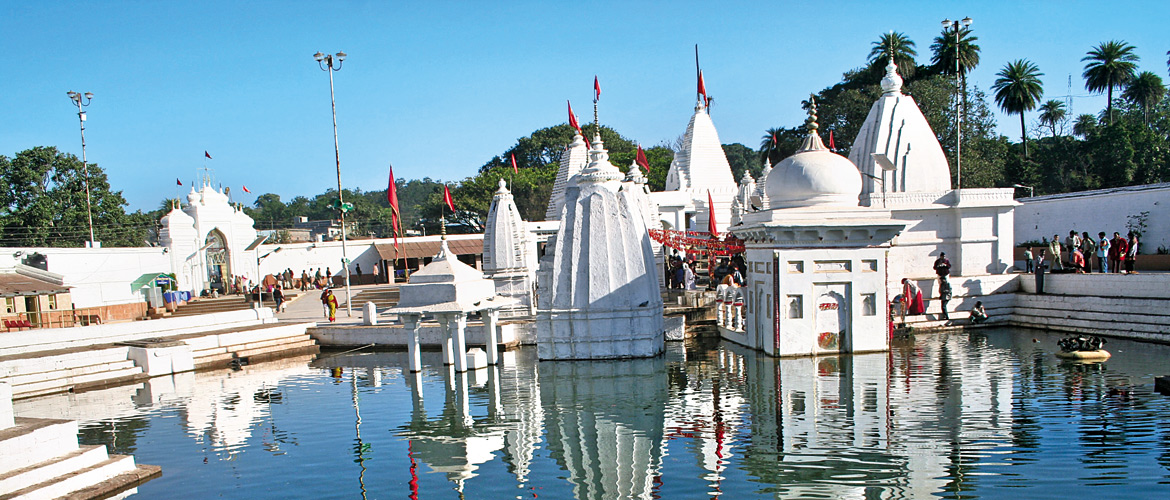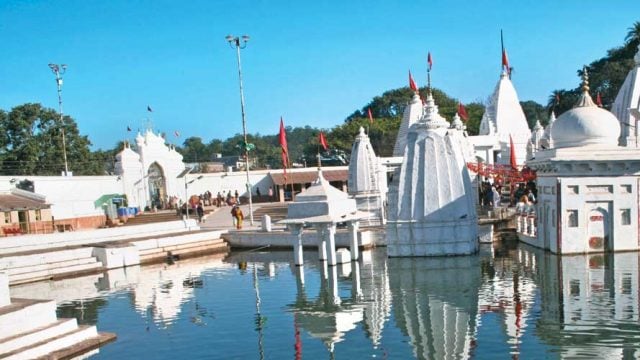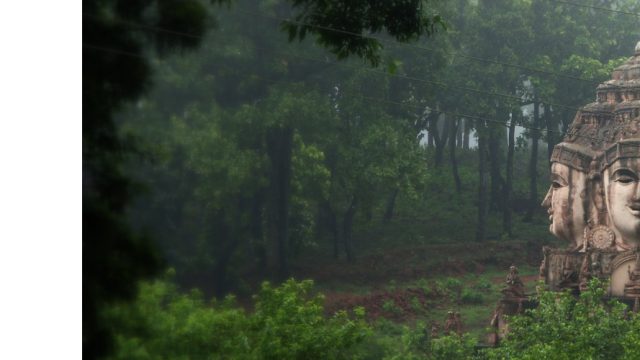Rewa: the jumping one. Maikal Suta: the one born of the Maikal Hills. Shiva’s child. Mother of

Narmada Udgam Complex
This is a walled complex of shrines; the sacred kund is its focus, from which the Narmada is believed to have emanated. The kund is full of devotees bathing or performing rites. The sparkling white shrines are situated around two tanks. The water from the holy tanks pours out from a spout in the form of a gao mukh (literally cow’s mouth). The 18th-century Narmada Temple, commissioned by the Bhonsle kings of Nagpur, houses a black stone image of the river goddess with large silver eyes. There is a small pond the devotees step down to, in order to scoop up water in their palms which is then sprinkled on the image of the goddess. Every year, on the occasion of Narmada Jayanti, the blackbasalt statue of the river goddess is draped in brocade and worshipped by hordes of zealous worshippers. Opposite her chamber is the shrine of the Amarkanteshwar Shivalinga. A group of 10th-century ruins known as Karna Matha temples, that were built by the Kalachuri Dynasty of Jabalpur, are located nearby. The ruins are surrounded by shrines that contain icons dedicated to Surya, Vishnu, Gorakhnath and Shivalingas.
Timings: 7.00 am–12 noon & 4.00–9.00 pm
Mata Narmada Temple
This temple faces the Narmada Udgam and is considered a Shaktipeeth. It sees scores of devotees, and of particular note here is a curious ritual performed by women. The ritual is apparently a ‘test of purity’ where women have to crawl out from under the statue of a dwarf elephant. If they manage this feat, their soul is believed to be pure.
Mai ki Bagiya
A kilometre away from the temple lies Mai Ki Bagiya, a shaded grove. The water of the kund here is believed to have originated from the feet of the Narmada. It is said that the goddess used to pluck flowers from this garden, which is now surrounded by shrines, a stream, medicinal plants and fruit-bearing trees.
Machhendranath and Pataleshwar
These ancient sandstone temples were built by the Kalachuri king Karnadeva in the 11th century. You may want to pay a visit to these temples to marvel at their exquisite carvings. They are situated to the south of the Narmada kund.
Karna Math Mandir
Locals ascribe this temple to a king called Raja Karan Dahariya or King Karna of Dahala, who was supposedly the ruler of Amarkantak. The Karna Math complex has three temples that have been constructed on a raised platform. The gate itself is crowned by four massive faces of the river goddess. Statues of 64 yoginis that represent the different aspects of the goddess adorn its walls. The temple tower rises in the form of the mythical Mount Meru. The temple is worth a visit for it intricate detailing alone, even if you aren’t particularly religious.
Son Muda
According to historical sources going back to the Greek historian Megasthenes (350–290 BCE), the River Son reportedly got its name from the gold dust that was discovered in its water. The area, believed to be the source of the river, now has a kund, a fairly new Shaktipeeth temple, a Shiva statue, as well as an old ashram. The beauty of the surroundings unravels after you descend the 100- odd steps cut into the hillside, and come to the very edge of the Amarkantak Plateau. From here, you can see the Son falling down the Maikul mountain, villages at a distance in the vast plains below and the many gentle folds of the Satpura Hills.
Kapildhara and Dudhdhara Falls
About 7km away from Amarkantak, towards the western edges of the plateau, lie the beautiful Kapildhara and Dudhdhara falls. Kapildhara is associated with the legendary sage Kapil or Kapila, who reputedly spent 12 years meditating here. Within these woods, the Narmada matures into a strong cascade of water splashing 70ft down sheer rock. Depressions in the rocks, before the cascade, are believed to be the footprints of the sage Kapila. You can drive up to the Kapildhara Viewpoint, but to look at it in its full glory and splash in the Narmada, walk half a kilometre down to the smaller but lovelier Dudhdhara Falls. Local jeeps are available here.

Where To Stay & Eat
The MPSTDC Holiday Home (Tel: 07629-269416; Tariff: ₹2,290–3,290) is clean and comfortable. They serve decent meals. Sarvodaya Vishram Griha (Tel: 269517; Tariff: ₹1,000–2,000) offers 23 rooms and a restaurant. The newer hotel, Shree Mata Sadan (Tel: 269520, Cell: 099939 14486, 09630371979; Tariff: ₹2,390–2,790), is situated on Sonunmuda Road. Among the ashrams, there’s a Jain Dharamshala (Tel: 269450, 269550; Tariff: ₹500–1,500), which is open to all. You may also opt for Sal Valley Restaurant (Cell: 09424164567; Tariff: `3,200–4,000), which is 22km from Amarkantak in village Keochi.
hills
Madhya Pradesh
narmada river




